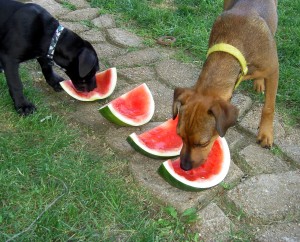 Food Energetics and Therapy
Food Energetics and Therapy
Chinese food therapy is as much a part of Traditional Chinese Medicine (TCM) as acupuncture or herbs. Part of the Chinese tradition is to have people and their pets eat seasonally available foods which help to balance the body. This creates a healthy digestive system which is important for the prevention of disease.
Energetics of Food
In the West food is described by its protein, fat and carbohydrate content. By contrast, in the East food is described by the effect it has on the body when eaten, for example its temperature, flavor and route of action. The temperature of a food is either hot, warm, neutral, cool or cold. Chili peppers are very hot and therefore heat us up when eaten, whereas watermelon is cooling and therefore very appropriate on a hot summer day. Likewise, root vegetable soups warm us in the winter and salads cool us in the summer.
The flavor of a food is either salty, sour, bitter, sweet or pungent. A salty food (like tomatoes) can help cool and drain excess moisture from the body, while a sweet food (like string beans or chocolate) will moisten and nourish the body. A pungent or spicy food (like cinnamon) is warming and can help stimulate digestion, help with circulation, stimulate sweating and clear congestion. Bitter foods (like asparagus) are cooling and anti-inflammatory and can have a drying action while sour foods (apple) are cooling and drying. Both can be helpful in treating diarrhea.
A food is said to have a particular route of action, namely, it will have a preference for a particular meridian or organ. Walnuts can be used to benefit the Lungs, while almonds are said to enter the Kidneys.
The method of food preparation also affects how the food will be metabolized by the body. Highly processed foods (both human and dry kibble) release more heat and energy which creates more internal heat. Eating highly processed foods all the time can lead to chronic illnesses like diabetes, thyroid disease, autoimmune disease and cancer. Uncooked and raw foods tend to be cooling in nature, require more metabolic energy to burn and digest, and therefore tend to be more cooling for the body.
Applying Food Therapies
Food is medicine. Most of us fail to realize that just like drugs and herbs, foods influence how we think, feel and act. Next time you wake up with a stuffy nose or develop a headache, stop to consider what foods you’ve consumed (or stopped consuming) in the last 24 hours. I often apply this same rational to pets, questioning pet owners about changes made in the diet just prior to the onset of symptoms. At times the symptom is quickly resolved by the removal of just one offending food substance.
Food therapies are most commonly applied to skin problems, digestive problems, and respiratory problems. Supplements can be incorporated into a diet change to aid the digestibility of a particular food. A food is good only if the body is able to break down and absorb the nutrients in it. A good balanced and appropriate diet is the cornerstone of health which is the most important aspect of wellness for both you and your pet.
So during these hot summer months, consider adding some cooling foods to you or your pets diet……
Cooling (Yin) Foods
- Meat and Dairy – duck, egg, rabbit, most shellfish, turkey, yogurt
- Vegetable and Fruit – alfalfa, apple, banana, blueberry, broccoli, celery, cucumber, eggplant, kiwi, mango, mushroom, pear, persimmon, spinach, strawberry, tomato, watermelon
- Grain, Bean, and Other – barley, brown rice, buckwheat, most fish oil, flax (seed, oil), green tea, honey, millet, mint, soybean, tofu
Come fall consider adding some warming foods to your diet…..
Warming (Yang) Foods
- Meat and Dairy – chicken, lamb, venison,
- Vegetable and Fruit – apricot, blackberry, cherry, ginger, papaya, peach, red/chili pepper, plum, pumpkin, squash
- Grain, Bean, and Other – oats, quinoa, white rice, pepper, nutmeg, tumeric
The food below can be eaten all year round…..
Neutral Foods
- Meat and Dairy – beef, bison, catfish, mackerel, milk, pork, salmon, sardines, tripe, trout, tuna
- Vegetable and Fruit – asparagus, beet, cabbage, carrot, cauliflower, date, fig, lychee, pineapple, potato (white and sweet), radish, yam
- Grains, Beans, and Other – most beans, corn, peas (green)
So go ahead and enjoy a piece of watermelon, apple or pear as a snack or treat and see if you don’t notice a difference in the way you and your pet feels.
As a reminder, always go slow when adding new foods to your pet’s diet to limit any GI upset (diarrhea). Foods that should NEVER be fed to your pet include onions, grapes, raisins, macadamia nuts, chocolate and anything with artificial sweeteners (xylitol).